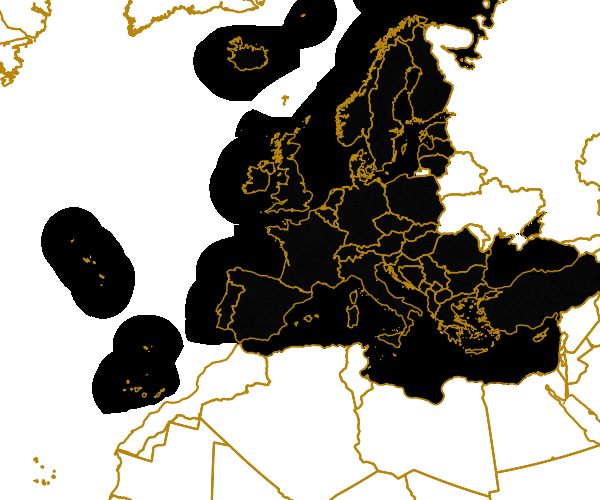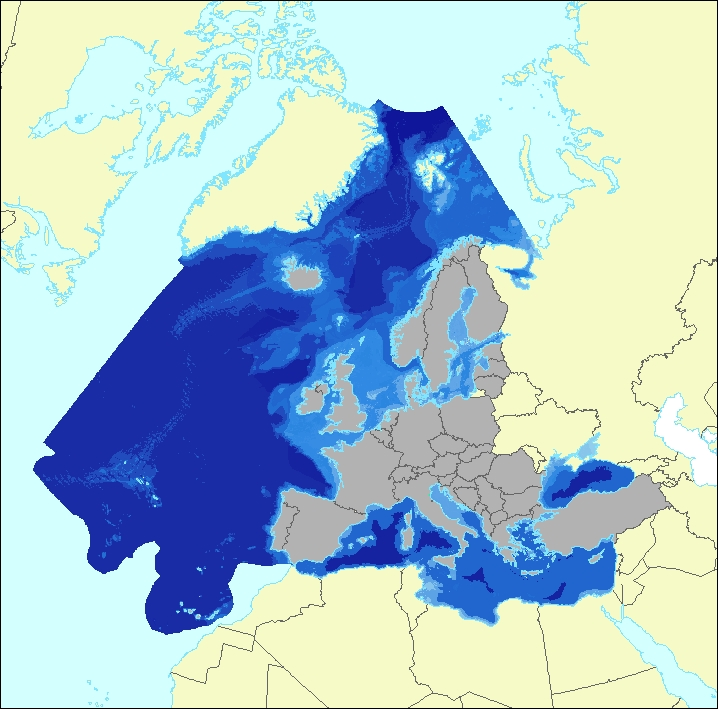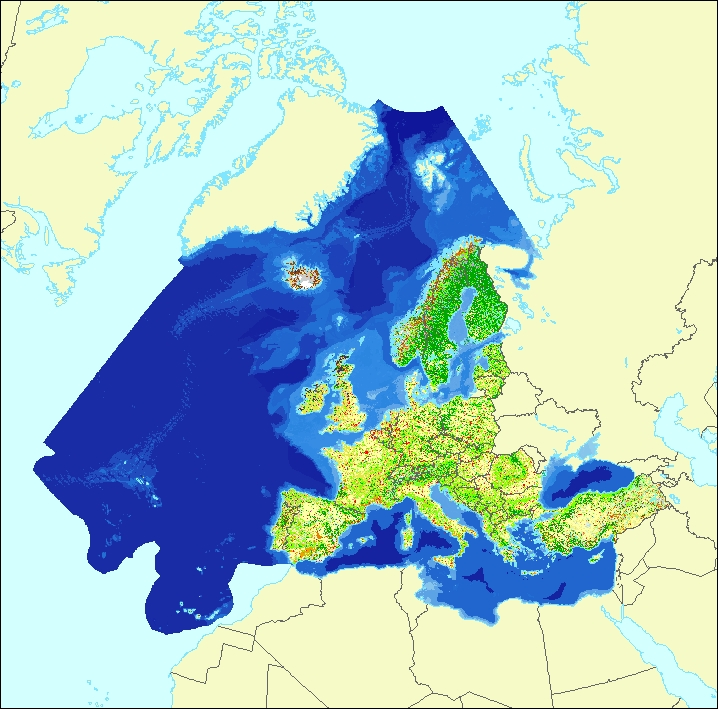ecosystem type
Type of resources
Available actions
Topics
INSPIRE themes
Keywords
Contact for the resource
Provided by
Years
Formats
Representation types
Update frequencies
status
Resolution
-

The data set aims to contribute to a better biological characterization of terrestrial ecosystems across Europe (EEA-39). As such it represents probabilities of EUNIS (EUropean Nature Information System) habitat presence at Level 2 (this corresponds to EUNIS level 3 for marine habitats). The map combines spatially explicit data on land cover information with non-spatially referenced habitat information of the EUNIS classification. The objective of the data set produced by EEA and its Topic Centre ETC/BD is to improve the biological description of land based ecosystem types and their spatial distribution across Europe. Since it is partly based on non-spatial explicit mapping the spatial and thematic accuracy is not of same quality as delineated maps. For terrestrial habitats the geometric and thematic accuracy is estimated in the reliability map 2012 v3.1 as secondary product. The work supports Target 2 Action 5 of the implementation of the EU Biodiversity Strategy to 2020, established to achieve the Aichi targets of the Convention of Biological Diversity (CBD). It further ad-dresses the MAES process (Mapping and Assessing of Ecosystems and their Services). The MAES ecosystem typology differentiates three levels and with certain differences follows the EUNIS classification: whereas MAES level 2 the proposal corresponds to EUNIS level 1, MAES level 3 follows closely the EUNIS level 2. A representation of MAES level 2 is contained in the reliability map as secondary product.
-

The data set combines the Corine based MAES (Mapping and Assessment of Ecosystems and their Services) ecosystem classes with the non-spatial EUNIS habitat classification for a better biological characterization of ecosystems across Europe (EEA-39). As such it represents probabilities of EUNIS habitat presence for each MAES ecosystem type. The data set aims to combine spatially explicit land cover information with non-spatially referenced habitat information to improve our knowledge about ecosystems and their distribution across Europe. The work supports the MAES process, Target 2 Action 5 of the implementation of the EU Biodiversity Strategy to 2020, established to achieve the Aichi targets of the Convention of Biological Diversity (CBD). The objective of the ecosystem data set produced by EEA and its Topic Centre ETC/SIA was to improve the biological description of land cover based ecosystem types. It represents probabilities of EUNIS habitat presence in ecosystem types at European level. Since it is not based on spatial explicit mapping the spatial and thematic accuracy is not of same quality as delineated maps. The MAES ecosystem typology differentiates three levels: whereas the level 2 of the MAES proposal follows closely the EUNIS level 1, the third level of the MAES typology corresponds to the EUNIS level 2. This level will be the base for the mapping approach.
-

The data set combines the Corine based MAES (Mapping and Assessment of Ecosystems and their Services) ecosystem classes with the non-spatial EUNIS habitat classification (LEVEL 1) for a better biological characterization of ecosystems across Europe (EEA-39). As such it represents probabilities of EUNIS habitat presence for each MAES ecosystem type. The data set aims to combine spatially explicit land cover information with non-spatially referenced habitat information to improve our knowledge about ecosystems and their distribution across Europe. The work supports the MAES process, Target 2 Action 5 of the implementation of the EU Biodiversity Strategy to 2020, established to achieve the Aichi targets of the Convention of Biological Diversity (CBD). The objective of the ecosystem data set produced by EEA and its Topic Centre ETC/SIA was to improve the biological description of land cover based ecosystem types. It represents probabilities of EUNIS habitat presence in ecosystem types at European level. Since it is not based on spatial explicit mapping the spatial and thematic accuracy is not of same quality as delineated maps. The MAES ecosystem typology differentiates three levels: whereas the level 2 of the MAES proposal follows closely the EUNIS level 1, the third level of the MAES typology corresponds to the EUNIS level 2. This level will be the base for the mapping approach.
-

The data set combines the Corine based MAES (Mapping and Assessment of Ecosystems and their Services) ecosystem classes with the non-spatial EUNIS habitat classification (LEVEL 1) for a better biological characterization of ecosystems across Europe (EEA-39). As such it represents probabilities of EUNIS habitat presence for each MAES ecosystem type. The data set aims to combine spatially explicit land cover information with non-spatially referenced habitat information to improve our knowledge about ecosystems and their distribution across Europe. The work supports the MAES process, Target 2 Action 5 of the implementation of the EU Biodiversity Strategy to 2020, established to achieve the Aichi targets of the Convention of Biological Diversity (CBD). The objective of the ecosystem data set produced by EEA and its Topic Centre ETC/SIA was to improve the biological description of land cover based ecosystem types. It represents probabilities of EUNIS habitat presence in ecosystem types at European level. Since it is not based on spatial explicit mapping the spatial and thematic accuracy is not of same quality as delineated maps. The MAES ecosystem typology differentiates three levels: whereas the level 2 of the MAES proposal follows closely the EUNIS level 1, the third level of the MAES typology corresponds to the EUNIS level 2. This level will be the base for the mapping approach.
-

The data set combines the Corine based MAES (Mapping and Assessment of Ecosystems and their Services) ecosystem classes with the non-spatial EUNIS habitat classification (LEVEL 2) for a better biological characterization of ecosystems across Europe (EEA-39). As such it represents probabilities of EUNIS habitat presence for each MAES ecosystem type. The data set aims to combine spatially explicit land cover information with non-spatially referenced habitat information to improve our knowledge about ecosystems and their distribution across Europe. The work supports the MAES process, Target 2 Action 5 of the implementation of the EU Biodiversity Strategy to 2020, established to achieve the Aichi targets of the Convention of Biological Diversity (CBD). The objective of the ecosystem data set produced by EEA and its Topic Centre ETC/SIA was to improve the biological description of land cover based ecosystem types. It represents probabilities of EUNIS habitat presence in ecosystem types at European level. Since it is not based on spatial explicit mapping the spatial and thematic accuracy is not of same quality as delineated maps. The MAES ecosystem typology differentiates three levels: whereas the level 2 of the MAES proposal follows closely the EUNIS level 1, the third level of the MAES typology corresponds to the EUNIS level 2. This level will be the base for the mapping approach.
-

The data set aims to contribute to a better biological characterization of European marine ecosystems. As such it represents probabilities of EUNIS (EUropean Nature Information System) habitat presence at Level 3 for marine habitats including information on sea ice coverage (this corresponds to EUNIS level 2 for terrestrial habitats). The map combines spatially explicit data on marine bathymetry and sea-bed with non-spatially referenced habitat information of the EUNIS classification. The objective of the data set produced by EEA and its Topic Centre ETC/ULS is to improve the biological description of marine based ecosystem types and their spatial distribution. The work supports Target 2 Action 5 of the implementation of the EU Biodiversity Strategy to 2020, established to achieve the Aichi targets of the Convention of Biological Diversity (CBD). It further addresses the MAES process (Mapping and Assessing of Ecosystems and their Services). The data set represents 2 classes of the MAES classification level 3, namely “Marine inlets and transitional waters” and “Marine”. The dataset comprises the following information: • Sea region (1 – Arctic, 2 – Atlantic, 3 – Baltic, 4 – Mediterranean, 5 – Black Sea) • Sea zone (1 – Littoral, 2 – Infralittoral, 3 – Circalittoral, 4 – Offshore circalittoral, 5 – Upper bathyal, 6 – Lower bathyal, 7 – Abyssal,8 - Coastal Lagoons, 9 - Coastal Lagoons) • Substrate (0 – undetermined substrate, 1 – rock and biogenic, 3 – coarse sediment, 4 – mixed sediment, 5 – sand, 6 – mud) • Sea ice coverage (0 – no sea ice presence, 1 – seasonal sea ice presence, 2 – perennial sea ice presence)
-

The data set is a secondary product accompanying the terrestrial part of the Ecosystem Type Map 2012 v3.1. It provides supplemental information: • estimated geometric reliability ranging from 1 – 10 (very low to very high) • estimated thematic reliability ranging from 1 – 10 (very low to very high) • Main original LC input data source: - Corine Land Cover - Urban Atlas - Riparian Zones - Natura 2000 (N2k) - High Resolution Layer Forest - High Resolution Layer Grassland - High Resolution Layer Imperviousness - High Resolution Layer Permanent Water Bodies - OpenStreetMap Roads - OpenStreetMap Landuse • MAES Level 2 (Urban, Cropland, Grassland, Woodland and Forest, Heathland and shrub, Sparsely vegetated land, Wetlands, Marine inlets and transitional waters)
-

The data set aims to contribute to a better biological characterization of marine and terrestrial ecosystems across Europe (EEA-39). As such it represents probabilities of EUNIS (EUropean Nature Information System) habitat presence at Level 2 for terrestrial habitats and corresponding Level 3 for marine habitats (including information on sea ice coverage). The map combines spatially explicit data on marine bathymetry and sea-bed and land cover information with non-spatially referenced habitat information of the EUNIS classification. The objective of the data set produced by EEA and its Topic Centres ETC/BD and ETC/ULS is to improve the biological description of marine and land based ecosystem types and their spatial distribution across Europe. Since it is partly based on non-spatial explicit mapping the spatial and thematic accuracy is not of same quality as delineated maps. For terrestrial habitats the geometric and thematic accuracy is estimated in the reliability map 2012 v3.1 as secondary product. The work supports Target 2 Action 5 of the implementation of the EU Biodiversity Strategy to 2020, established to achieve the Aichi targets of the Convention of Biological Diversity (CBD). It further addresses the MAES process (Mapping and Assessing of Ecosystems and their Services). The MAES ecosystem typology differentiates three levels and with certain differences follows the EUNIS classification: whereas MAES level 2 the proposal corresponds to EUNIS level 1, MAES level 3 follows closely the EUNIS level 2. For terrestrial habitats a representation of MAES level 2 is contained in the reliability map as secondary product.
 RUC Geo-Data catalogue
RUC Geo-Data catalogue